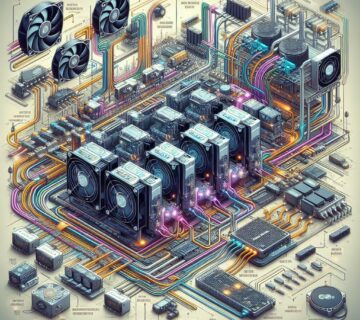Setting off on a voyage through the mysterious world of technology’s never-ending development, an intriguing phenomena that is enthralling both industry and people at large appears. A game-changing idea is about to take off, one that will completely change how we think about transactions, information security, and stranger trust. Get ready for an exploration into the mysterious world of blockchain technology, a breakthrough that is upending the foundation of our online life. This piece aims to disentangle the intricacies associated with blockchain technology, clarifying its internal mechanisms and illuminating its diverse range of uses. Come along on a journey through the complex network of blockchain, where riddles involving cryptography await solutions and a decentralized utopia awaits those who are brave enough to understand it.
Table of Contents
- How Does Blockchain Technology Work?
- Key Features and Benefits of Blockchain Technology
- Potential Applications of Blockchain Technology
- Challenges and Limitations of Blockchain Technology
- Recommendations for Implementing Blockchain Technology
How Does Blockchain Technology Work?

Blockchain technology is revolutionizing the exchange and storage of digital data by acting as a transparent, decentralized ledger that records each exchange or interaction within a network. It represents a paradigm change as it does not require a central authority, enabling several parties to keep a synchronized copy of a document. But learning more about this cutting-edge technology’s complex inner workings begs the question, “How does it work?”
A blockchain is primarily made up of a series of blocks, each of which represents a set of authorized transactions. A hash, which is a unique identifier produced by cryptographic techniques, is included in every block. Maintaining the integrity of the block and associated transactions depends heavily on its hash. Because of the intricacy of the cryptographic process, altering the hash would require modifying the block, which is an impractical job in terms of computing power.
Furthermore, blockchain functions as a peer-to-peer network in which various users, referred to as nodes, validate and verify transactions. These nodes use mining, or the use of computational power to solve challenging mathematical riddles. The miner creates a new block to the chain and distributes it to other nodes for validation whenever a problem is solved. Consensus protocols, such Proof of Stake (PoS) or Proof of Work (PoW), are used to make sure that nodes agree on the legitimacy of transactions. In conclusion, blockchain technology offers a reliable and safe alternative to centralized authority for data storage and transaction processing.
Key Features and Benefits of Blockchain Technology
Blockchain technology has revolutionized our perception of data management and security, introducing key features and benefits that make it a powerful and innovative solution:
Decentralization:
With blockchain, there is no central authority or single point of control. Data is stored across a network of computers known as nodes, making it resistant to censorship and manipulation. This decentralized nature ensures transparency and enhances trust in the system.
- Immutability: Once data is added to the blockchain, it cannot be altered or deleted. This makes it ideal for applications where data integrity is crucial, such as financial transactions or supply chain management.
- Security: Blockchain employs cryptographic techniques to secure data, making it highly resistant to hacking and fraud. The use of public and private keys ensures that only authorized individuals can access and validate information.
- Traceability: Every transaction and data entry in the blockchain is timestamped and linked to previous entries, creating an auditable trail. This feature is especially valuable for industries like healthcare and food, where traceability is vital for quality control and accountability.
 Efficiency:
Efficiency:
Blockchain technology offers numerous efficiency benefits, including:
- Streamlined processes: By eliminating intermediaries and the need for manual verification, blockchain reduces administrative overhead and speeds up transaction times.
- Cost savings: With its decentralized nature, blockchain eliminates the need for trust in third parties, reducing transactional costs and lowering fees for users.
- Enhanced cross-border transactions: Blockchain eliminates the need for traditional intermediaries, making cross-border transactions faster, cheaper, and more efficient.
Organizations may reap a multitude of advantages by adopting blockchain technology, including increased productivity and cost reductions as well as greater security and transparency. Because of its decentralized structure and unchangeable records, it is perfect for applications where data integrity and trustworthiness are crucial. This technology has a genuinely extraordinary potential to affect many sectors as it continues to improve.
Potential Applications of Blockchain Technology
Blockchain technology is more than just cryptocurrencies; it has the power to completely transform a wide range of sectors and companies. Let’s examine a few fascinating uses for blockchain technology:
1. Supply Chain Management
Blockchain technology is more than just cryptocurrencies; it has the power to completely transform a wide range of sectors and companies. Let’s examine a few fascinating uses for blockchain technology:
2. Healthcare Records
Blockchain technology has great promise for enhancing medical record administration. Healthcare workers may obtain accurate and up-to-date information instantly by safely storing patient data on a distributed ledger. Interoperability between various healthcare providers may be eased and patient privacy can be safeguarded thanks to blockchain’s built-in security features. This improves productivity, lowers medical mistakes, and gives individuals more authority over their health information.
3. Voting Systems
Blockchain technology shines as a light of openness and confidence in election systems, stepping onto the complex nexus of technology and democratic processes. Votes are recorded and verified as irreversible transactions on the blockchain by its tamper-proof design, which makes manipulation nearly impossible. By doing away with the necessity for middlemen, this decentralized method guarantees that every vote is safely counted. Blockchain technology has the ability to strengthen democratic processes and restore public confidence in elections by eliminating uncertainties and risks.
Challenges and Limitations of Blockchain Technology

Blockchain technology offers increased security, transparency, and efficiency in a variety of industries, pushing the boundaries of breakthrough innovation. However, like to every technical advancement, it has obstacles and constraints that are necessary for a thorough comprehension of its possibilities.
Scalability is one of the main issues facing blockchain technology. On a blockchain network, the volume of transactions increases with system load. Current design limitations slow down transaction processing, which leads to long transaction times and higher expenses. This restriction may make it more difficult for blockchain technology to become widely used, especially in sectors where large transaction volumes are required.
The fact that blockchain depends on power usage is another drawback. Networks need a significant amount of processing power and energy, especially those that use proof-of-work consensus procedures. This increases the impact on the environment and drives up expenses for network users. As we move toward a more sustainable future, it is critical to address blockchain networks’ energy use.
Adoption of blockchain technology is further complicated by privacy and data protection concerns. Transparency is innate, but for certain businesses and people, there has to be a careful balance between privacy and data transparency. Blockchain’s immutability makes it difficult to manage sensitive or personal data. Achieving this equilibrium is essential for blockchain technology to be accepted and relied upon by a variety of parties.
In conclusion, even if blockchain technology has a lot of potential, it’s critical to recognize its current drawbacks and obstacles. Resolving obstacles including scalability, energy usage, and privacy issues is necessary. Overcoming these challenges and realizing the full potential of blockchain technology across sectors is feasible with ongoing study and innovation.
Recommendations for Implementing Blockchain Technology
Blockchain technology has revolutionized transactional conduct and data management. To fully exploit its transformative potential, correct implementation within your organization is crucial. Here are recommendations to navigate this process seamlessly:
- Identify the problem: Prior to blockchain implementation, distinctly define the problem to be addressed. Blockchain is not a one-size-fits-all solution; understanding specific needs guides the selection of the right blockchain platform or the creation of a customized one. Consider factors such as transaction volume, data security, and the need for transparency.
- Collaborate with experts: Given the complexity of blockchain technology, seeking assistance from experts streamlines implementation. Collaborate with experienced blockchain developers, consultants, and industry veterans who can guide through each step. Thorough research and selecting partners aligned with organizational goals are imperative.
- Prepare for scalability: While blockchain technology can handle large transaction volumes, scalability challenges must be addressed early. Choose a blockchain platform capable of accommodating increased transaction loads without compromising performance. This ensures system robustness as your organization expands and the demand for blockchain solutions grows.
Successful blockchain implementation demands careful planning, collaboration, and a deep understanding of organizational needs. By adhering to these recommendations, you pave the way for a seamless transition, harnessing the transformative power of blockchain technology.
In Retrospect

We hope that after reading this insightful examination of blockchain technology, you have a better knowledge of this ground-breaking invention. Blockchain has captured the attention of people worldwide, promising to transform a multitude of sectors, much like a mystical thread winding through the digital world.
Blockchain provides an unmatched degree of efficiency, security, and transparency to a wide range of industries, including voting systems, healthcare, banking, and supply chain management. Because it is decentralized, it empowers people and promotes trust in a globalized society.
However, there are several difficulties in this technical marvel. During our voyage, we learned about consensus algorithms, smart contracts, and cryptographic hashesвАФthe fundamental components of the blockchain ecosystem.
We saw the emergence of cryptocurrencies, which redefined money and added a dash of technological innovation. Entering the world of mining, where strong computer algorithms verify and protect transactions and pay users for keeping the blockchain’s integrity.
Blockchain is more than just digital money platforms; it’s a paradigm change and a chance to reestablish transparent, trust-based social systems. It pushes us to reconsider current structures and welcome a decentralized, democratic, and liberating future.
We hope you will continue exploring the world of blockchain while we say goodbye. Examine its possibilities in fields including intellectual property, identity verification, and even the battle against climate change. Because this is where blockchain’s revolutionary potential really manifests itself.
Watch how this technology develops whether you decide to become a blockchain fan, developer, or just an interested bystander. The opportunities are endless since the seeds have already been sown. The digital environment is being shaped by blockchain technology, which is presenting us with an incredible view of the future.






